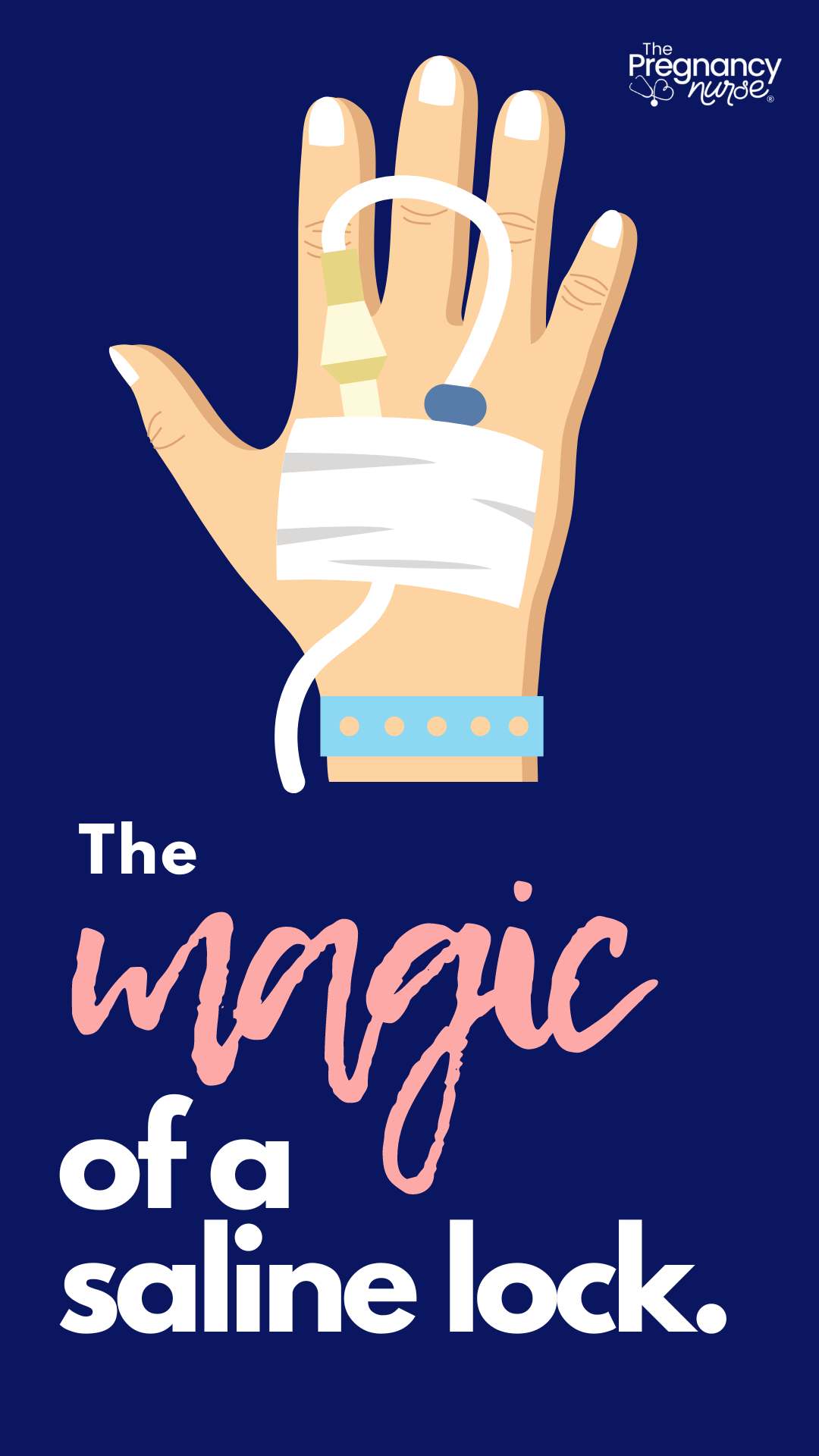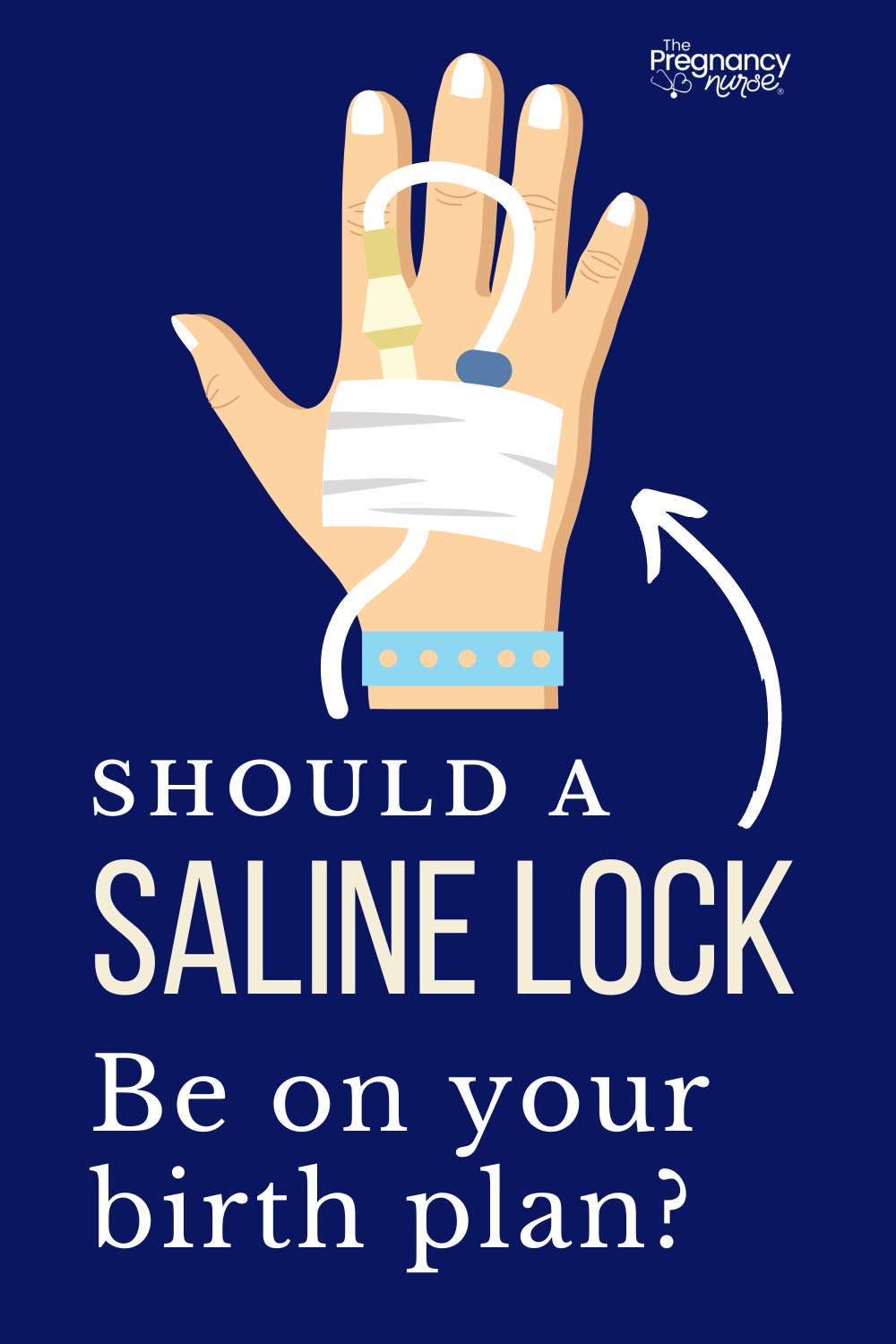👋 I’m so glad YOU are here. Are you looking to also get your partner prepared? This is for BOTH of you. Couples just love it and I know you want to both feel prepared!
The saline lock (formerly known as a hep lock) is an under-utilized tool in labor that can allow you the safety of having an IV with it’s less-restrictive nature. It’s something you may be able to consider!

FYI — A saline lock might be something you put on your birth plan. BUT, make sure you’re making yours the RIGHT way — come join me as we make it together in a way that will both help YOU and the staff know how to best help you:
What is a Saline Lock
It’s really simple. The saline lock has an IV in place, but leaves just a port where fluids or medications can be hooked up without that tube needing to be constantly in your arm.
It allows for the safety of HAVING quick access if we need it, while also not requiring you to be hooked up to tubing.
A lot of people find it to be:
- Less “medical” or “sick” feeling — and I think the hospital can make you feel that way!
- Allow for more movement because you’re not worried about it tugging or pulling on the tubing
Who can use a saline lock?
In general, it’s for lower risk births. Mostly, there are reasons you can’t have a saline lock:
- If you’re actively getting medications (obviously, the tubing has be hooked up for that)
- If you have an epidural going we need to have an IV infusing
So, that generally takes out anyone having a Pitocin induction. HOWEVER, if you come in for cervical ripening, you can use a saline lock until medications need to be infused.
Also, if you’re GBS positive we can hook-up the medications when ordered. They take about an hour to infuse, and then we can un-hook it after that.
- When Will The Hospital Admit You For Labor?
- What Happens If You’re Sent Home From The Hospital In Early Labor?
- Your Guide On What To Wear In Labor & Delivery And Your Hospital Stay
- Do You Have To Give Birth On Your Back In The Hospital?
- When To Pack Your Hospital Bag: Get Prepared With The Pregnancy Nurse
Pro’s to the Saline Lock
The main thing that we, as nurses, are looking for is access to your circulatory system. If something goes wrong we want to be able to inject fluids, medications and possibly even blood quickly and not waste time trying to get in an IV.
It also gives IV pain medications as an option in labor too!
I know you think, “how hard can it be?” — but if your body is shutting down trying to get an IV in becomes 400 times harder (not to mention the stress of a life-or-death-situation at that point).
Also, we can often place it when we draw your lab work that is ordered when get into the hospital. That means one poke, and done!

Con’s to the Saline Lock
You still have to get the poke. Many people want to refuse the IV, in general, because they don’t want to have the needle in their arm.
However, you really need to decide if your fear of needles is worth very poor outcomes if something was to go wrong. I think the saline lock normally is a great, happy medium.
Remember, when we place an IV in (in almost all cases — you can check with your nurse if you have ANY questions) we remove the needle after putting the flexible plastic tube into your vein.
Some people still hate the tubing on their arm (there is a small amount of tubing that extends out from your arm that allows us to “plug in”). If that is the case I often will grab some stocking (what we often use to cover wounds) and cover it up so nothing catches on it and you don’t have to look at it.
Where does the saline lock go?
Most often in the forearm.
As labor nurses we really try to not put it the joint of your elbow area. That area is too easily “kinked” off when pushing or handling baby (often right when we need the IV the very most). So, we try to put it in your forearm. If that doesn’t work sometimes it’s the hand.
You can learn more about IV’s in labor in general <<right there
If you have a place you’d prefer you can always let your nurse know, but nurses take a long and hard look at the available veins and it is often best to let them pick the spot they feel most confident about.
Want to know more about hospital routines, check out these posts:
- Why NOT to Take Your Birth Class at the Hospital
- 5 Things to Avoid at the Hospital (in Labor and Delivery)
- Things to Do Before Going to the Hospital for Delivery
- When to Go To The Hospital for Decreased Fetal Movement?
- What to pack in Your Hospital Bag: Your Labor & Delivery Checklist
How can I find out if it’s right for me?
I think it’s smart to talk with your doctor or midwife about it at your next appointment, but then also put it on your birth plan. That will help remind you, and the staff that you’d like to try that.
Sometimes in the “heat” of labor or going into the hospital you forget about things like this that will allow you more autonomy and movement — so having it on your birth plan will easily remind the staff what you’d like.
The other good thing is that if we think you could use some IV fluids for a bit, we can infuse them for a while and then take them off — leaving you with a saline lock. I found this very common in summer where people would come-in dehydrated and some IV fluids helped them feel better but they didn’t need them long term.
Honestly, learning what your options are in labor can be a HUGE benefit for you. I recommend getting your advice from an expert who can explain the pro’s and con’s so you can make the choice for yourself. We call that shared decision making in healthcare and I’m a HUGE fan of it.
The Online Prenatal Class for Couples was created to help you understand your options. Yes, we’re going to go from beginning to end through deliveries (including inductions and cesareans) — but along the way I’m going to show you all the choices you have to make that birth just for you. Thousands of couples have loved it. Hundreds have reviewed it. I hope I’ll see you inside!
Want to do a vibe check before diving into the whole thing with me? — check out my free labor pro tips. It’s your first step toward getting in the driver’s seat of your birth.










 Can Summer Heat Hurt Your Pregnancy?
Can Summer Heat Hurt Your Pregnancy?
